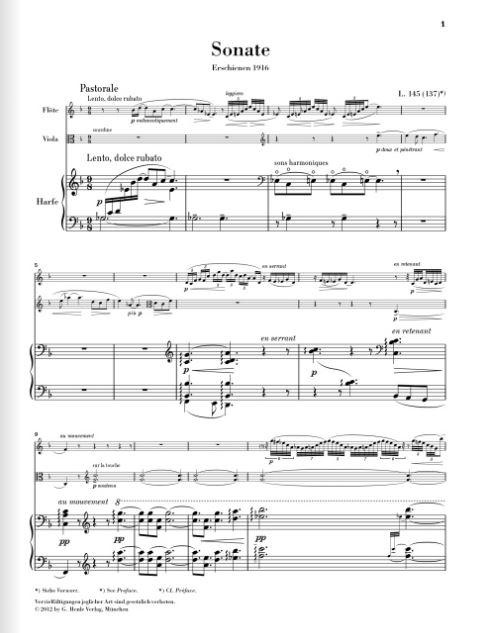
Happy Present Meet
Debussy Sonata for Flute, Viola and Harp
L.145(137)
드뷔시 플루트, 비올라, 하프를 위한 소나타
The middle work in the three late chamber music sonatas was composed in spring 1915, directly after the cello sonata (HN 633). The innivative combination of sounds – a wind instrument, a stringed instrument, and a plucked instrument – greatly contributes to the impression of restrained melancholy. Debussy himself confirmed it, saying: “It is terribly sad. And I do not know whether one should laugh or cry about it? Perhaps both at the same?” On another occasion he emphasized the similarities with his own compositional style of the 1890s, remarking of the sonata: “It reminds me of a very old Claude Debussy – the one of the Nocturnes.”.
세 개의 후기 실내악 소나타 중 중간 부분은 첼로 소나타(HN 633) 바로 직후인 1915년 봄에 작곡되었습니다. 관악기, 현악기, 그리고 건반악기라는 독창적인 소리의 조합은 절제된 우울감을 조성하는 데 크게 기여합니다. 드뷔시 자신도 이를 인정하며 이렇게 말했습니다. "정말 슬프군요. 웃어야 할지 울어야 할지 모르겠습니다. 어쩌면 동시에 웃어야 할지도 모르겠습니다." 또 다른 경우에 그는 1890년대 자신의 작곡 스타일과의 유사성을 강조하며 이 소나타에 대해 이렇게 말했습니다. "아주 오래된 클로드 드뷔시의 작품, 녹턴을 떠올리게 합니다."
편곡자 Jost, Peter
작곡가 Debussy, Achille Claude (1862-1918)

Purcell Aria "What Shall I Do" (from "Dioclesian")for Cello and Piano
Rachmaninoff Prelude, Op.2 No.1 for Cello and Piano
Tchaikovsky Trio in A minor Op.50
Cassado Requiebros in D Major for Cello and Piano
Cassado Lamento de Baobdil for Cello and Piano
Shostakovich Cello Concerto No.2, Op.126 for Cello and Piano
Kabalevsky Concerto No.1 Op.49 for Cello and Piano
Arensky Trio in d minor, Op.32 for Violin, Cello and Piano